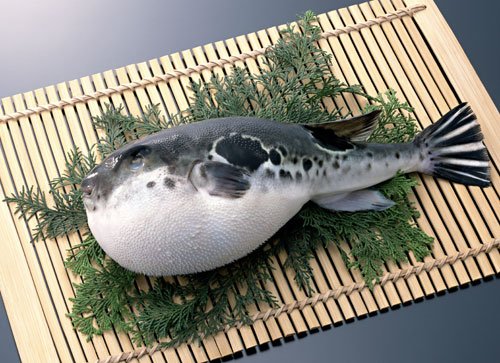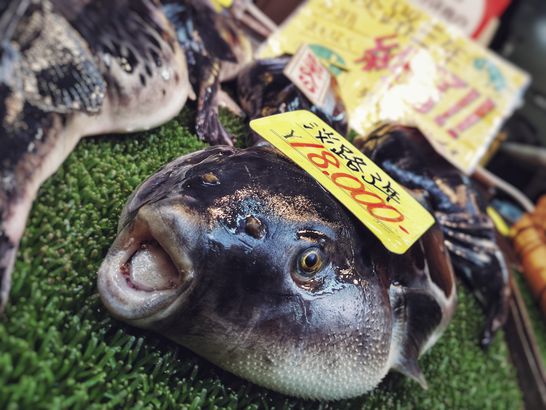

Joshua Levine, Smithsonian Magazine, 20 Nov. 2021 Many people worry that raw-milk cheese is a kind of edible petri dish of contagion and disease, a dangerous delicacy not unlike Japanese fugu, the poisonous blowfish, which, if not prepared expertly, can kill you. Jessica Poitevien, Travel + Leisure, 29 Nov. 2022 In fact, eating fugu is so dangerous that it was outlawed in the 16th century, though many secretly kept the tradition alive. (Note: I'm going to try to write more posts here.if you have anything you want me to write about that's not a recipe (because my recipe-request list is a mile long already), give me a holler, on Facebook or Twitter, or even the comments here.Recent Examples on the Web While some fish of this species are edible when handled correctly - like fugu, a delicacy in Japan - this one is not. See also: Fugu: Would you or wouldn't you? So, that's how fugu got its name, and became legal in Japan. He was also pictured on the 1,000 yen bill in my youth, which imprinted that face with the big frizzy beard on my mind. Because we share the same family name, although I'm sure there's no relationship (Ito/Itoh 伊藤 is like the 4th or 5th most common family name in Japan), I've always been a bit fascinated by this larger than life man with more than his share of controversy. In between, he had an extremely colorful life which included lots of affairs (which his ever-patient wife tolerated, only getting angry at him if the woman he had seduced ended up hurt or pregnant), and was a famous gourmet and dandy, not to mention a skillful politician. And on the other end, he was assassinated by a Korean nationalist.

Hirobumi Ito was a fascinating, complicated character in his younger days he made his way to England on a British ship with a friend, neither of whom spoke a word of English or had every been outside of Japan, and came back fluent and was intrumental in writing the first modern Japanese constitution, using the British and Prussian consitutions as models. He subsequently worked on the laws to make it legal to serve fugu, provided you knew what you were doing. Legend has it that Hirobumi Ito, who became the first Prime Minister of modern Japan in the Meiji Period and who was from Choshu-han, had some fugu for the first time as an adult and was amazed at how toothsome and delicious it was. Fugu continued to be eaten secretly in some areas of Japan though, especially along the coast in Choshu-han, current day Yamaguchi prefecture. During the Edo period (1603 -1868), eating fugu was regarded as a very unpatriotic, disobedient thing to do, especially for samurai, who were supposed to reserve their lives for their lord. So how did a poisonous fish become legal?įugu was actually banned in Japan for a long time (as it was in China for some periods). Osaka-ites have a rather sarcastic sense of humor. This is because, like a pistol, sometimes a fugu, if it's not properly broken down to remove the poison, can really hurt you. In Osaka it's sometimes called a 鉄砲 or てっぽう - teppo, meaning pistol. There are other, regional names or nicknames for the pufferfish. An even older kanji for fugu is 布久 - fuku - which is even more of an ateji than 河豚. This one makes a lot more sense since the left side is a radical that indicates fish (sakana-hen), and the right side is a radical that is part of 腹 - stomach or belly - which can be read as fuku. There's also another kanji for fugu which is seen occasionally, 鰒.
#Fugu meaning tv
(I've never wrestled with a live fugu, but I have seen them on TV a few times and they do make a kind of "boo, boo" sound.) Never mind that the fugu the Japanese ate came from the sea. Pufferfish were called 'fugu' in Japan anyway, so someone decided to just use the Chinese hanzi characters and read them as 'fugu'. This is a bothersome and very common thing that happened, and to an extent still happens, in Japanese called 'ateji' - where kanji are applied and forcibly read a certain way, regardless of grammatical rules and the like.

"But.but", you student of Japanese are saying, 'river 河’ and 'pig 豚’ aren't read as 'fu' and 'gu' at all!" True. Apparently when they were caught, they made a wheezing sound that sounded like the oinks of a pig. The pufferfish that the Chinese used to eat centuries ago were found in large freshwater bodies of water such as the Yangtze River. She was pondering the use of 豚, the second character, which means "pig", but the first character 河 is a mystery too, since it means river - and the fugu that we know and eat today (or get all het up about how dangerous it is, depending on where you are from) is an ocean fish. A friend was wondering out loud on Facebook, why the kanji characters for fugu (pufferfish) are 河豚.


 0 kommentar(er)
0 kommentar(er)
